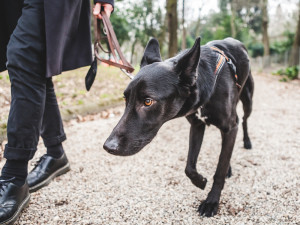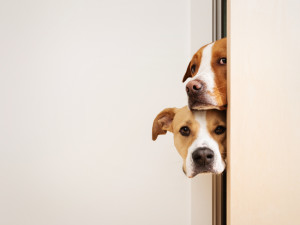7 Main Reasons Why Your Dog Is Whining All the Time—and How to Stop It
When the whining never stops, it’s time to do some detective work.

Share Article
In This Article:
Why Is Your Dog Whining All the Time? What to Do About Excessive Whining When to Get a Professional Trainer
Dogs are loyal companions, enthusiastic tail-waggers, and occasional couch thieves. They’re also master communicators, using barks, tail wags, soulful stares, body language, and whining to express their emotions. Sometimes, those soft, high-pitched sounds are endearing. Other times, whining can be annoying, especially when you don’t understand how to interpret what your dog is trying to say.
Before you start looking for dog psychologists, take a deep breath. Whining is a sign that your dog needs attention — not necessarily an emergency, but something worth addressing. Here’s a breakdown of why dogs whine, what you can do to ensure you don’t get a headache, and that your pup is well-understood and cared for.
Main takeaways
Dogs whine to express needs or emotions such as attention, discomfort, fear, boredom, or excitement.
Persistent or unusual whining may indicate pain or medical issues, and your pup should be evaluated by a veterinarian.
Observing context clues and body language helps determine whether whining signals an urgent need or a less critical request.
Positive reinforcement training and sufficient exercise and stimulation can reduce unnecessary whining.
Professional trainers can address underlying issues like anxiety, helping improve communication and minimize excessive whining.
Why is your dog whining all the time?
1. They are seeking attention
Dogs are social animals, and whining is often a way to grab your attention. They may be hungry, bored, or need pets and affection. If whining gets a reaction from you — even a frustrated one — they’ve learned that it works.

2. They are expressing pain or discomfort
Whining can be a way for dogs to tell you that something hurts. According to Dr. Alisha Kidwellopens in new tab, an experienced and reliable veterinarian at North Carolina’s Cabarrus Animal Hospital, persistent whining often indicates discomfort or pain. Schedule a trip to the vet if your dog’s whining seems unusual, and they are limping, licking a particular spot, or showing signs of distress.
3. They are asking for something
Sometimes, whining is a dog’s way of making a polite request. Do they need to go outside? Do they want a treat from the cookie jar? If your dog stares at you while whining, they need you to decipher their canine code.
4. They are expressing fear or stress
Loud noises, unfamiliar environments, and new people or animals in the house can trigger whining. This is how dogs can express anxiety, and sometimes whining indicates unease. They feel stressed, anxious, or fearful if their ears are pinned back or their tails are tucked.
5. They are bored
A bored dog is whinier than average. If your dog lacks mental or physical stimulation, they may whine because they have nothing better to do. It is their version of asking you to play or do something with them.
6. They have separation anxiety
If your dog starts whining when you leave the room or house, they may have separation anxiety. Dogs with this condition whine excessively. They may pace or become destructive when alone because all their energy is focused on how they feel when separated from you.
7. They are communicating excitement
Not all whining is negative. Sometimes dogs whine because they feel excited. Their body language expresses excitement, such as joyful eyes and a wagging tail. They are letting you know they can’t wait for whatever comes next.
What to do about excessive whining in dogs
Some dogs are dramatic, using whining to test the patience of the most loving pet parents. The key to restoring peace in your home is to discover why your dog is whining. Remember, whining is a dog’s way of communicating, so your job is to pay attention to the pitch and body language to figure out why they’re expressing themselves this way.
There are practical ways to manage and minimize whining. You can turn whining into a manageable method of communication by ruling out medical concerns, paying attention to patterns, and setting clear boundaries.
Make sure there are no medical issues
Contact a veterinarian to rule out health problems. If your dog’s whining is sudden, unusual, or paired with symptoms like a change in appetite or lethargic behavior, there could be something medically amiss.
Determine what may be causing the whining
When, where, and why is your dog whining? Are they whining near their food bowl at dinnertime? Are they sitting by the window and whining at the neighbors? Pay attention to your dog’s behavior and body language. Context clues can help you decode their whining.
Determine what is a critical issue and what isn’t
Some whining deserves immediate attention (like if they are in pain or need to go outside). Other times, whining is less urgent, like when your dog is begging for leftover sandwich crusts while you’re eating lunch. Learn to prioritize so you don’t spend your day catering to your dog’s demands.
Provide positive reinforcement training for non-critical issues
Hold off for a few minutes if your dog is whining for attention. Don’t give in immediately. Wait until they calm down, then reward them with praise, treats, and affection. This teaches them that silence and peace — not whining — earn your attention and positive response.
Make sure your dog is getting enough exercise and stimulation
Tired dogs are typically quiet and peaceful. Daily walks, playtime, and mentally stimulating toys can help burn off excess energy, reducing the risk of whining out of boredom. A bored dog is a toddler on a sugar high. Keep them busy, and they will whine less.
When should you work with a professional trainer for help?
If your dog’s whining stems from issues like fear or anxiety, a professional trainer can help. They can assist with tackling the root cause of the whining — not just the symptoms. Think of it as therapy for your pup and peace of mind for you.
Trainers can teach you tools and techniques to better understand and communicate with your dog. They help you foster a stronger bond and more precise boundaries, whether helping your dog build confidence or learning self-soothing behaviors. Professional guidance can make a difference by teaching your dog (and you) to unlearn habits that may be distressing or triggering, contributing to whining.
Professional dog trainers often spot subtle cues or triggers you may otherwise overlook. They can help you address whining issues more effectively, setting up you and your pup for long-term success.
FAQs
Should you ignore a whining dog?
Sometimes. You should ignore a whining dog when they are begging for attention, and you’re sure nothing is immediately wrong. Ignoring them teaches them that whining won’t work to get your attention. However, if they’re in pain, scared, or requesting something (like going outside), don’t ignore them —address the issue.
Which dog breed whines the most?
Some dog breeds are more vocal than others. For instance, Siberian Huskies, Beagles, and Dachshunds are notable chatterboxes, and whining is part of their reputations. However, they can be trained to stop whining unless something is wrong.
When should you be worried about dog whining?
If whining is sudden, excessive, or paired with symptoms like limping, vomiting, or lack of appetite, it’s cause for concern. Your vet will help you figure out if something is wrong.
References
“Why Is My Dog Whining So Much All of a Sudden – [Vet Explains Pets].” Vetexplainspets.com, 2024, vetexplainspets.com/why-is-my-dog-whining-so-much-all-of-a-suddenopens in new tab. Accessed 30 Dec. 2024.
“Why Is My Dog Whining All the Time – [Vet Explains Pets].” Vetexplainspets.com, 2024, vetexplainspets.com/why-is-my-dog-whining-all-the-timeopens in new tab. Accessed 30 Dec. 2024.

Valerie Mellema
Valerie Mellema has a Bachelor of Science in Agribusiness and Equine Industry from West Texas A&M University. She has been a professional writer for the past 20 years, covering a wide variety of pet health and care topics before founding a nonprofit focused on mental health in children and thoroughbred aftercare. She has four Border Collies and eight retired racehorses.

Danielle Vrabel, CPDT-KA
Danielle Vrabel is a dog trainer who earned her CPDT-KA in 2020. Danielle is a proud pet mom of five pets: two dogs, two cats, and a corn snake. Danielle has fostered over ten dogs and fifteen cats and kittens, as well as helped train shelter dogs before they are adopted. Both of Danielle’s dogs are pet therapy dogs, where she also volunteers her time helping evaluate future therapy dogs.
Related articles
![Dog Lays On The Ground Barking]()
Dog Speak: The Sounds of Dogs
Decoding the many sounds your pup makes.
We Answer the Age-Old Question: Why Do Dogs Howl?
How to help a howling dog turn down the volume (or even hit the off button).
![Boxer dog sits in back of car with head in the front]()
How Do I Stop My Dog From Crying In the Car?
Is there anything more annoying than a dog who won’t stop whining? Here’s what to do about it.
![Shy black dog walking with owner at the park.]()
How to Help an Anxious Dog Conquer Their Fears
Pro tips for boosting the confidence of a scaredy-cat dog.
![Two fearful adolescent dogs peeking through a slightly open door]()
Puppy Fear Periods: Why is My Dog Scared All of a Sudden?
Turns out, adolescence isn’t just tough for humans—it can be hard on dogs, too.
![Dog barking]()
How to Stop Your Dog From Barking
The top five reasons dogs bark—and how to get them to relax a bit.








